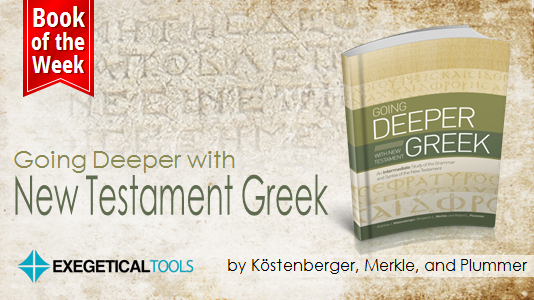
For two decades, Wallace’s Greek Grammar Beyond the Basics has been the favorite textbook for intermediate Greek courses in seminaries and Christian colleges and universities. As much as we all owe a debt to Wallace’s grammar with its comprehensiveness, exegetical discussions, and useful charts, it is now two decades old and outdated on important issues such as verbal aspect. Many professors also require supplemental texts to teach concepts not found in Wallace.
One element missing compared to Wallace’s textbook is the exegetical discussions Wallace would include on significant syntactical issues (e.g., whether John 1:1 says the Word was “God” or “a god”). However, Going Deeper found a more systematic way to provide the student with exegetical guidance. They conclude each chapter with a long passage to translate, followed by notes on each verse to help the student translate and to reinforce concepts taught in that chapter. The passages start out easy (Mark 1:1-13) and progressively become more difficult (the last being Heb 5:11-6:6). They have therefore cleverly integrated a graded reader into the textbook so students don’t need to buy another reader such as Decker’s (although his would be a great supplement, since he includes passages outside the NT as well).
There are several other features that make this textbook pedagogically superior to other intermediate grammars.
- Each chapter includes vocabulary to memorize and recognize, which negates the need for a separate vocabulary book.
- Every chapter includes several charts that visually reinforce each concept taught in that chapter.
- An appendix collates syntactical categories found in eleven other grammars (e.g., Robertson, Moule, BDF, Turner, Zerwick, etc.) so the student can see how the categories they are being taught compare to other systems.
- The first chapter introduces the Greek language and its diachronic stages, and several common changes from Attic to Koine.
- The first chapter also introduces the student to the principles of textual criticism.
- Chapter 13 introduces the student to traditional sentence diagramming and to discourse analysis. Although no method is taught, the authors refer students to external resources to learn how to do both. It is probably better that no discourse analysis method is taught, since the discipline is so variegated and most methods are so eclectic (e.g., see recent handbooks on discourse analysis from Routledge, Wiley Blackwell, and Bloomsbury).
- Chapter 14 teaches principles for doing word studies, provides recommended resources, and gives a short example.
- The final chapter concludes with encouragement to continue with Greek and ideas to do so.
One last notable feature of this grammar is its chapter on tense and verbal aspect. Wallace’s grammar was published only 4 years after the two major monographs on Greek verbal aspect were published, so it is unfortunately outdated. Going Deeper gives a useful and (in my opinion) accurate description of the three aspects in Greek (perfective, imperfective, and stative) with warnings about how the aspectual value of verbs can be altered or even cancelled out by grammaticalization.
I could continue with laudable elements of the book, and I could also provide several instances where I was slightly puzzled or felt I would explain the concept differently, but that’s entirely expected with an intermediate textbook. Overall, I would spend much less time arguing against or “correcting” various concepts taught in this book than I have had to spend while teaching from Wallace’s.
I do think this textbook is now the most pedagogically friendly intermediate Greek grammar for students and teachers.
Now the most pedagogically friendly intermediate Greek grammar for students and teachers. Share on XBuy it here on Amazon.

